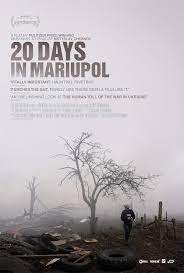
20 DAYS IN MARIUPOL
Ukraine, 2023, 95 minutes, Colour.
Directed by Mstyslav Chernov
A significant documentary for its time. And a significant documentary in future years for any assessment of Russia’s invasion of Ukraine in 2022 and its subsequent history.
This documentary has won several awards and is a nominee for the Academy Award for Best Documentary.
Mstyslav Chernov is a celebrated Ukrainian journalist, photojournalist, committed to peace causes. (It is worth checking his Wikipedia entry especially to see the number of awards, and their wide range, that he has received while still in his 30s, including the Pulitzer Prize.)
He was in the southern coast city of Mariupol on February 24th 2022 when Vladimir Putin made a press announcement (seen in this documentary) announcing a special operations in Ukraine, attributing aggression to Ukraine, Nazi attitudes. However, this was a follow-up to the invasion of Crimea in 2014 and its annexation and Russia’s territorial ambitions – with memories of interactions between Russia and Ukraine in previous centuries as well as Stalin’s treatment of Ukraine in the 1930s famine.
The director was reporting for Frontline, American PBS channel. This documentary, covering the almost 3 weeks that the director was in the city before leaving to take his footage to be available for the wider world, catching up with the Red Cross convoy, was edited into this feature documentary and released, screening at the Sundance Festival, a month before the first anniversary of the Russian invasion.
In Australia, the film, Oscar-nominated, became available just after the second anniversary of the invasion – and the uncertainties about the future of the conflict. While the language of the film is all about the present, those three weeks in 2022, audiences in 2023 watched it in the retrospect of one year of the war. With the second anniversary of the war, 2024, the war had lasted 730 days. So much warfare, so much Ukrainian spirited resistance, the leadership of President Zeleneky, assistance from Europe and NATO, from other allies including Australia, the ups and downs of financial and arms support from the United States.
So, audiences, including those influenced by the Oscar nomination, are watching the events two years later. Which, of course, in no way diminishes the horror, the violence, the atrocities, the sufferings and death, family bereavements, the pressures on doctors and nurses, bombardments, lack of resources, hunger… And the thousands who left the city.
And, for those watching the film in 2024, there is also the experience of making comparisons with the war in Gaza, the experience of the Palestinians from the Israeli invasion and bombardments following the Hamas brutal attack, the parallels of doctors and nurses, lack of means, the many deaths, injuries and the sadness of the bereaved, as Well Is the bewilderment of the survivors.
This is painful watching even for those comfortably observing from afar. This is a kind of necessary documentation that needs to be kept, seen, lest we forget. The director and his associates spent a lot of time in the hospitals, documenting the work of the doctors and nurses, the difficulties, and filming out in the streets, significantly the filming of pregnant women, the babies, the children, the deaths and the grief-stricken parents. The director trying to track down the pregnant woman in the bombed streets and finding she had died. The father mourning the death of his son, 16-year-old, playing soccer when the bombs fell.
The accusations against the Russians with the bombing and the arrival of the tanks and bombardments are strong, condemning the seemingly targeted attack on civilians – denied by the Russians, spokespersons on Russian television, officials at international meetings, as well as that unfortunate heritage from Donald Trump, “fake news”, the Russians insisting that so many of the scenes in those 20 days at Mariupoll were movie sets with actors performing.
That was in the first three weeks of the war. In the ensuing months and years, there have still been denials, but the evidence is clear, the importance of photojournalists, filmmakers, photographing and recording on the spot so that evidence is not lost but finds its place in asking for empathy from the world, but also providing material for judgement and condemnation.